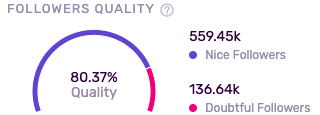How to Detect Fake Followers or Fake Influencers
Learn how Influencity identifies false or inactive accounts.
Influencity uses natural language processing and image recognition technology to identify the accounts that are not useful to your influencer marketing strategy.
Natural Language Processing
This branch of AI allows a computer to read all public captions and comments in a profile. Just like a real-life user, our technology looks at a profile and can identify certain “red flags” that include:
- “Spammy” text that comes across as unnatural, given the context.
- Repetitive comments left by similar profiles. Social media bots are often created in batches and are programmed to have the same behavior. As such, groups of bots may repeatedly interact with a certain profile or with each others' profiles.
- Excessive sharing of links. Like the point above, bots are often created to get a message out, and they do this through the sharing of links and comments.
- No recent posts. If the last post was over 6 months ago, it’s likely that this is an infrequent or inactive user who will not see your sponsored posts.
Note: Bots are computer programs designed to mimic human activity online.
Image Recognition Technology
This technology allows software to "see" a profile and pick up on patterns that seem suspicious. Some fake profiles, for example, may not have a profile picture. Others may have the exact same photo uploaded across various accounts. This is especially true of bots created in the same batch.
Identifying these accounts manually is a time-consuming process. It would involve going through an account’s list of followers and scanning each profile one by one. Fortunately, one of the many advantages Influencity offers is the ability to cross-check all of these profiles and identify the behaviors and patterns listed above. This information is then compiled into the follower quality metric in your IRM.
